5 books about Whalen, Michael E.
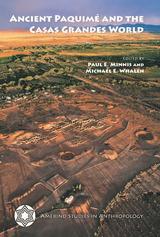
Ancient Paquimé and the Casas Grandes World
Edited by Paul E. Minnis and Michael E. Whalen
University of Arizona Press, 2015
Paquimé, the great multistoried pre-Hispanic settlement also known as Casas Grandes, was the center of an ancient region with hundreds of related neighbors. It also participated in massive networks that stretched their fingers through northwestern Mexico and the U.S. Southwest. Paquimé is widely considered one of the most important and influential communities in ancient northern Mexico and is a UNESCO World Heritage Site. Ancient Paquimé and the Casas Grandes World, edited by Paul E. Minnis and Michael E. Whalen, summarizes the four decades of research since the Amerind Foundation and Charles Di Peso published the results of the Joint Casas Grandes Expeditions in 1974.
The Joint Casas Grandes Expedition revealed the extraordinary nature of this site: monumental architecture, massive ball courts, ritual mounds, over a ton of shell artifacts, hundreds of skeletons of multicolored macaws and their pens, copper from west Mexico, and rich political and religious life with Mesoamerican-related images and rituals. Paquimé was not one sole community but was surrounded by hundreds of outlying villages in the region, indicating a zone that sustained thousands of inhabitants and influenced groups much farther afield.
In celebration of the Amerind Foundation’s seventieth anniversary, sixteen scholars with direct and substantial experience in Casas Grandes archaeology present nine chapters covering its economy, chronology, history, religion, regional organization, and importance. The two final chapters examine Paquimé in broader geographic perspectives. This volume sheds new light on Casas Grandes/Paquimé, a great town well-adapted to its physical and economic environment that disappeared just before Spanish contact.
The Joint Casas Grandes Expedition revealed the extraordinary nature of this site: monumental architecture, massive ball courts, ritual mounds, over a ton of shell artifacts, hundreds of skeletons of multicolored macaws and their pens, copper from west Mexico, and rich political and religious life with Mesoamerican-related images and rituals. Paquimé was not one sole community but was surrounded by hundreds of outlying villages in the region, indicating a zone that sustained thousands of inhabitants and influenced groups much farther afield.
In celebration of the Amerind Foundation’s seventieth anniversary, sixteen scholars with direct and substantial experience in Casas Grandes archaeology present nine chapters covering its economy, chronology, history, religion, regional organization, and importance. The two final chapters examine Paquimé in broader geographic perspectives. This volume sheds new light on Casas Grandes/Paquimé, a great town well-adapted to its physical and economic environment that disappeared just before Spanish contact.
[more]
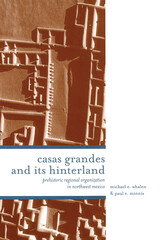
Casas Grandes and Its Hinterlands
Prehistoric Regional Organization in Northwest Mexico
Michael E. Whalen and Paul E. Minnis
University of Arizona Press, 2001
Casas Grandes, or Paquimé, is one of the most important settlements in the prehistoric North American Southwest. The largest and most complex community in the Puebloan world, it was characterized by its principal excavator, Charles Di Peso, as an outpost of the Toltec empire, which used it as a trade link between Mesoamerican and southwestern cultures. Michael E. Whalen and Paul E. Minnis have worked extensively in the Casas Grandes area and now offer new research arguing that it was not as similar to the highly developed complex societies of Mesoamerica as has been thought. In the first book of its kind in 25 years, the authors analyze settlement pattern data from more than 300 communities in the area surrounding Casas Grandes to show that its Medio period culture was a local development. Whalen and Minnis propose that Casas Grandes lacked extensive stratification, well-established decision-making hierarchies, and formalized positions of authority. They suggest instead that emerging elites used bribes, promises, and threats to build factions and extend their power. The communities at the periphery are shown to have had varying levels of social and economic interaction with Casas Grandes. This innovative study offers a new model for the rise and fall of Casas Grandes that departs considerably from the view most scholars have come to accept and will be of interest to all concerned with the comparative study of emergent complexity. It clearly shows that the idea of extensive regional centralization by Casas Grandes is no longer tenable and merits reconsideration by the archaeological community.
[more]
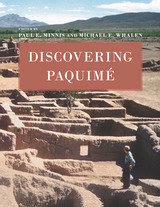
Discovering Paquimé
Edited by Paul E. Minnis and Michael E. Whalen
University of Arizona Press, 2016
In the mid-1560s Spanish explorers marched northward through Mexico to the farthest northern reaches of the Spanish empire in Latin America. They beheld an impressive site known as Casas Grandes in the Mexican state of Chihuahua. Row upon row of walls featured houses and plazas of what was once a large population center, now deserted. Called Casas Grandes (Spanish for “large houses”) but also known as Paquimé, the prehistoric archaeological site may have been one of the first that Spanish explorers encountered. The Ibarra expedition, occurring perhaps no more than a hundred years after the site was abandoned, contained a chronicler named Baltasar de Obregón, who gave to posterity the first description of Paquimé:
". . . many houses of great size, strength, and height . . . six and seven stories, with towers and walls like fortresses for protection and defense against the enemies who undoubtedly used to make war on its inhabitants . . . large and magnificent patios paved with enormous and beautiful stones resembling jasper . . ."
Casas Grandes, now a UNESCO World Heritage Site, is under the purview of the Instituto Nacional de Antropología e Historia, which oversees a world-class museum near the ruins. Paquimé visitors can learn about the site’s history and its excavations, which were conducted under the pioneering research of Charles Di Peso and Eduardo Contreras Sánchez and their colleagues from INAH and the Amerind Foundation.
Based on a half century of modern research since the Joint Casas Grandes Project, this book explores the recent discoveries about important site and its neighbors. Drawing the expertise of fourteen scholars from the United States, Mexico, and Canada, who have long worked in the region, the chapters revel new insights about Paquimé and its influence, bringing this fascinating place and its story to light.
". . . many houses of great size, strength, and height . . . six and seven stories, with towers and walls like fortresses for protection and defense against the enemies who undoubtedly used to make war on its inhabitants . . . large and magnificent patios paved with enormous and beautiful stones resembling jasper . . ."
Casas Grandes, now a UNESCO World Heritage Site, is under the purview of the Instituto Nacional de Antropología e Historia, which oversees a world-class museum near the ruins. Paquimé visitors can learn about the site’s history and its excavations, which were conducted under the pioneering research of Charles Di Peso and Eduardo Contreras Sánchez and their colleagues from INAH and the Amerind Foundation.
Based on a half century of modern research since the Joint Casas Grandes Project, this book explores the recent discoveries about important site and its neighbors. Drawing the expertise of fourteen scholars from the United States, Mexico, and Canada, who have long worked in the region, the chapters revel new insights about Paquimé and its influence, bringing this fascinating place and its story to light.
[more]
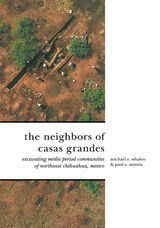
The Neighbors of Casas Grandes
Medio Period Communities of Northwestern Chihuahua
Michael E. Whalen and Paul E. Minnis
University of Arizona Press, 2009
Casas Grandes, or Paquimé, in northwestern Mexico was of one of the few socially complex prehistoric civilizations in North America. Now, based on more than a decade of surveys, excavations, and field work, Michael Whalen and Paul Minnis provide a comprehensive new look at Casas Grandes and its surrounding communities in The Neighbors of Casas Grandes.
This volume provides a fascinating and detailed look into the culture of the Casas Grandes area, involving not just the research of the architecture and artifacts left behind but also the ecology of the area. The authors’ research reveals the complex relationship Casas Grandes had with its neighbors, varying from very direct contact with some communities to more indirect links with others. Important internal influences on the area’s development come to light and population sizes throughout the period demonstrate the absorption of the surrounding populations into Casas Grandes as it reached the peak of its power in the region.
New discoveries suggest the need to revise the previously held beliefs about the age of Casas Grandes and the dates of its rise to power. This ancient civilization may have developed as early as 1180 AD. Such breakthroughs provide fresh insight about not only Casas Grandes but the nearby settlements as well. The Neighbors of Casas Grandes is an important and vital piece of primary field research for all those interested in the Southwest’s archaelogy and history. Its contribution to the knowledge of the Casas Grandes region is monumental in helping us better understand the society that once flourished there.
This volume provides a fascinating and detailed look into the culture of the Casas Grandes area, involving not just the research of the architecture and artifacts left behind but also the ecology of the area. The authors’ research reveals the complex relationship Casas Grandes had with its neighbors, varying from very direct contact with some communities to more indirect links with others. Important internal influences on the area’s development come to light and population sizes throughout the period demonstrate the absorption of the surrounding populations into Casas Grandes as it reached the peak of its power in the region.
New discoveries suggest the need to revise the previously held beliefs about the age of Casas Grandes and the dates of its rise to power. This ancient civilization may have developed as early as 1180 AD. Such breakthroughs provide fresh insight about not only Casas Grandes but the nearby settlements as well. The Neighbors of Casas Grandes is an important and vital piece of primary field research for all those interested in the Southwest’s archaelogy and history. Its contribution to the knowledge of the Casas Grandes region is monumental in helping us better understand the society that once flourished there.
[more]
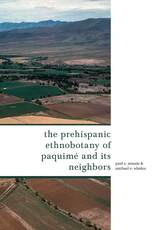
The Prehispanic Ethnobotany of Paquimé and Its Neighbors
Paul E. Minnis and Michael E. Whalen
University of Arizona Press, 2020
Paquimé (also known as Casas Grandes) and its antecedents are important and interesting parts of the prehispanic history in northwestern Mexico and the U.S. Southwest. Not only is there a long history of human occupation, but Paquimé is one of the better examples of centralized influence. Unfortunately, it is also an understudied region compared to the U.S. Southwest and other places in Mesoamerica.
This volume is the first large-scale investigation of the prehispanic ethnobotany of this important ancient site and its neighbors. The authors examine ethnobotanical relationships during Medio Period, AD 1200–1450, when Paquimé was at its most influential. Based on two decades of archaeological research, this book examines uses of plants for food, farming strategies, wood use, and anthropogenic ecology. The authors show that the relationships between plants and people are complex, interdependent, and reciprocal. This volume documents ethnobotanical relationships and shows their importance to the development of the Paquimé polity.
How ancient farmers made a living in an arid to semi-arid region and the effects their livelihood had on the local biota, their relations with plants, and their connection with other peoples is worthy of serious study. The story of the Casas Grandes tradition holds valuable lessons for humanity.
This volume is the first large-scale investigation of the prehispanic ethnobotany of this important ancient site and its neighbors. The authors examine ethnobotanical relationships during Medio Period, AD 1200–1450, when Paquimé was at its most influential. Based on two decades of archaeological research, this book examines uses of plants for food, farming strategies, wood use, and anthropogenic ecology. The authors show that the relationships between plants and people are complex, interdependent, and reciprocal. This volume documents ethnobotanical relationships and shows their importance to the development of the Paquimé polity.
How ancient farmers made a living in an arid to semi-arid region and the effects their livelihood had on the local biota, their relations with plants, and their connection with other peoples is worthy of serious study. The story of the Casas Grandes tradition holds valuable lessons for humanity.
[more]
READERS
Browse our collection.
PUBLISHERS
See BiblioVault's publisher services.
STUDENT SERVICES
Files for college accessibility offices.
UChicago Accessibility Resources
home | accessibility | search | about | contact us
BiblioVault ® 2001 - 2024
The University of Chicago Press









